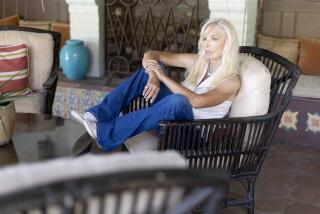Art review: Lew Thomas at Cherry and Martin
Lew Thomas’ first U.S. solo exhibition in almost 20 years focuses on work from the 1970s, creating a kind of bridge between the early days of Conceptual art and the 1980s “Pictures” generation. In this sense, the content and style of the show at Cherry and Martin is familiar; more surprising is the way Thomas’ deadpan sense of humor comes through.
“34 Avenue Between Geary and Clement” from 1972 is a series of photographs of every building on a San Francisco block. It’s urban density’s answer to Ed Ruscha’s 1966 “Every Building on the Sunset Strip.” Elsewhere, Thomas’ work aligns with that of artists like Sherrie Levine and Louise Lawler, who shifted art’s focus to the context surrounding the work. In 1978, Thomas photographed the bibliography from “Photography and Language,” a book published by his NFS Press, as well as its various iterations in other publications. He considered these images “Reproductions of Reproductions.”
Perhaps most striking is “9 Perspectives,” a slightly off-kilter view of a living room and two doorways that Thomas pieced together from nine partial photographs of the space. The 1972 image is a precursor to David Hockney’s 1980s Polaroid collages in which vision is shattered into myriad, discrete moments. Thomas’ work is subtler but no less insightful for the ways in which it makes us aware of the limited and fleeting nature of our own vision.
CRITICS’ PICKS: What to watch, where to go, what to eat
Time and the effort to measure it appear to also have been a preoccupation. “Light-On-Floor” from 1974 is a grid of images that captures the path of a shaft of light across a dark floor. “Time/Temperature” appears to be simply a series of 15 photos of a nondescript storefront until you realize that Thomas synchronized his snaps with the changing time and temperature readings on an outdoor LED display. In this sense, photography allows us to see not only through its own mechanical lens but also how another machine whiles away the day.
This sense of fascination with other ways of seeing also undergirds Thomas’ work. “Sink: Filling/Filled/Draining/Drained” is a 12-frame document of the process its title describes. “36 Kinds of White on 34th Avenue” is a 36-print catalog of all manner of “white” surfaces, from walls to shirts to light bulbs, none of which is exactly the same shade. The result in both cases is a breaking up of otherwise seamless experiences into discrete rectangular chunks or what could be considered the very definition of photography.
Thomas goes at this idea directly in the piece “Black & White” from 1971. The piece consists of two prints: On top is the word “BLACK” printed in white on a black background. Below, the word “WHITE” is printed in black on a white background. To be legible, the words are precisely the opposite of what they say. This is photography stripped down to its basic elements — light and shadow — and it is still confounding.
Yet the most charming piece in the show is the only one in color. It is a grid of four Polaroids. In the first, Thomas has taken a picture of his hand. He then placed that image next to his hand and took another picture, and so on. Thomas ends up with a grid of hands of varying sizes, none of which is the real thing. We end up with an appreciation of representation as an endlessly fascinating hall of mirrors.
Cherry and Martin, 2712 S. La Cienega Blvd., (310) 559-0100, through April 26. Closed Sundays and Mondays. www.cherryandmartin.com
More to Read
The biggest entertainment stories
Get our big stories about Hollywood, film, television, music, arts, culture and more right in your inbox as soon as they publish.
You may occasionally receive promotional content from the Los Angeles Times.










